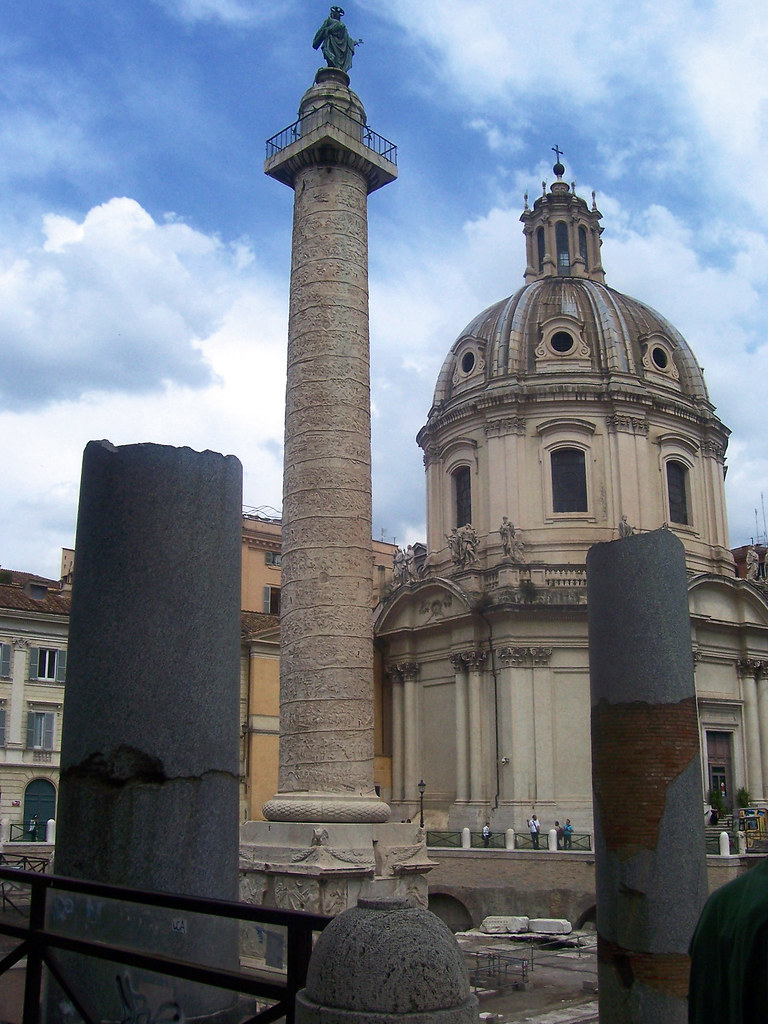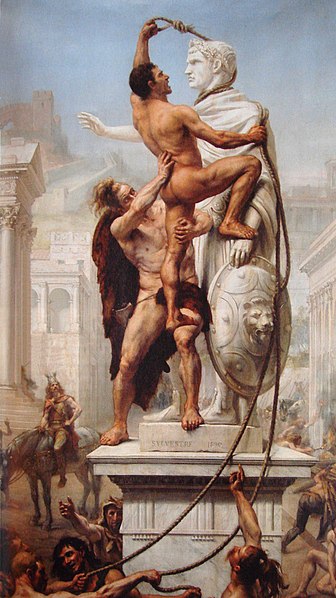The Fall of the Western Roman Empire was the process of decline in the Western Roman Empire in which the Empire failed to enforce its rule, and its vast territory was divided into several successor polities.

The Late Roman Empire Architecture
The First Roman Empire (ca. 0-200), also known as Pax Romana (“Roman Peace”), was the most prosperous and stable age of Roman history. The masterpieces of Roman architecture mainly date back to this period. However, the Late Roman Empire (ca. 200-500) had its share of magnificent buildings and is of particular interest as a transition phase to the Middle Ages.
With the decline of patronage, the economy, and the population there were fewer architects and engineers with skill or experience. Over time much of this knowledge was lost and would not have been rediscovered in the West until the High Middle Ages and thereafter.

Image source:https://search.creativecommons.org/photos/70351cd0-0eb6-4413-a670-8fff9a96a149

Image source: https://search.creativecommons.org/photos/b2a73100-e9fa-44d6-9480-184ac3e67c77

Image source:https://search.creativecommons.org/photos/b8d20417-cc8d-4b43-985c-b4472fb4e6e2 by Jorge Lascar
The Architectural Landmarks of the Falling Empire
Overall Western Roman architecture peaked in the early Principate to the mid-Dominate (a period spanning roughly 40sBC-300sAD). This saw the construction of famous buildings and landmarks like the Colosseum, the Pantheon, Trajan’s Forum and Column, and countless others.
The Flavian Amphitheater, more commonly known as the Colosseum, was built by Emperors Vespasian and Titus of the Flavian Dynasty in the early Imperial period while Trajan’s Forum, with his famous column, was built at the height of the Roman Empire right before its fall.
Finally, the Arch of Constantine was built during the very late Empire. It looks impressive enough, but many of its details were actually taken off older landmarks and cobbled back together on the Arch because artists and engineers simply didn’t have the same expertise as their earlier counterparts.

Image source: https://search.creativecommons.org/photos/993d315d-0e23-412a-a7e7-b8ba556e4785 by User:Alexander Z.
The Baths of Caracalla
The most ambitious building project of the Late Empire was the Baths of Caracalla. Baths were a standard feature of Roman cities, while the Baths of Caracalla were large and luxurious. In addition to the actual baths, the complex included exercise rooms, swimming pools, classrooms, and libraries. The interior was richly decorated with frescoes, sculptures, mosaics, and stuccos.

Image source:https://search.creativecommons.org/photos/08749186-d916-4d80-a8b5-aceb156c2d0a by teldridge+keldridge
How It Began
The Irreversible great territorial loss began in 376 with a large-scale raid by Goths and other tribes. Other barbarian groups crossed the Rhine and other frontiers of the empire, and finally, the invading army reached the outskirts of Rome, left undefended. In 410 C.E., the Visigoths, led by Alaric, breached the walls of Rome and sacked and burned the capital of the Roman Empire.
For the first time in nearly a millennium, the city of Rome was in the hands of someone other than the Romans.

Image source:https://it.m.wikipedia.org/wiki/File:Sack_of_Rome_by_the_Visigoths_on_24_August_410_by_JN_Sylvestre_1890.jpg
The Causes Behind the Fall
In September 476 AD, the last Western Roman emperor, Romulus Augustulus, was deposed by a Germanic prince named Odovacar, who had gained control of the remnants of the Roman army of Italy.
The Roman Empire had lost its strength, modern historians mention factors including the effectiveness and number of the army, the health, and numbers of the Roman population, the strength of the economy, the competence of the Emperors, internal struggles for power, the religious changes, and the efficiency of the civil administration. The growing pressure of the invading barbarians also contributed greatly to the collapse.

Image source: https://en.wikipedia.org/wiki/Migration_Period#/media/File:Invasions_of_the_Roman_Empire_1.png
The Historical Relevance
For many commentators, the fall of Rome marked the death knell of education and literacy, sophisticated architecture, advanced economic interaction and, the written rule of law.
The ‘dark ages’ that followed were dark both because of the written sources that were few and far between, but because life became ugly, brutal, and short.
However, other commentators saw the ‘dark ages’ as a more necessary evil – Rome had to fall to destroy slavery on a large scale and make possible a world that valued all human beings more fairly.
In both cases, the end of the Empire was nevertheless an important event in human history.

Image source: https://search.creativecommons.org/photos/a4004b57-9a51-46f4-8296-00cf0417570e
Info sources:
http://www.bbc.co.uk/history/ancient/romans/fallofrome_article_01.shtml
https://en.wikipedia.org/wiki/Fall_of_the_Western_Roman_Empire
http://www.ushistory.org/civ/6f.asp
